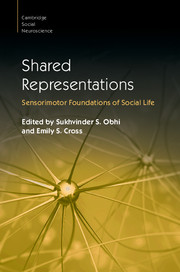Book contents
- Shared Representations
- Cambridge Social Neuroscience
- Shared Representations
- Copyright page
- Contents
- Figures
- Tables
- Boxes
- Contributors
- Preface
- Part I Foundations
- 1 What It Takes to Share a Task
- 2 Merged Minds
- 3 A New View of the Motor Cortex and Its Relation to Social Behavior
- 4 Beyond Action
- 5 Cognizance of the Neuroimaging Methods for Studying the Social Brain
- Part II Imitation and Mimicry
- Part III Thinking, Perceiving and Acting with Others
- Part IV Understanding Others
- Part V Learning and Development
- Part VI Shared Representations in Applied Contexts
- Index
- Plate Section (PDF Only)
- References
5 - Cognizance of the Neuroimaging Methods for Studying the Social Brain
from Part I - Foundations
Published online by Cambridge University Press: 27 October 2016
- Shared Representations
- Cambridge Social Neuroscience
- Shared Representations
- Copyright page
- Contents
- Figures
- Tables
- Boxes
- Contributors
- Preface
- Part I Foundations
- 1 What It Takes to Share a Task
- 2 Merged Minds
- 3 A New View of the Motor Cortex and Its Relation to Social Behavior
- 4 Beyond Action
- 5 Cognizance of the Neuroimaging Methods for Studying the Social Brain
- Part II Imitation and Mimicry
- Part III Thinking, Perceiving and Acting with Others
- Part IV Understanding Others
- Part V Learning and Development
- Part VI Shared Representations in Applied Contexts
- Index
- Plate Section (PDF Only)
- References
Summary
A key challenge in the study of the social brain resides not only in determining how psychological states and processes map onto patterns of brain activity but also how this activity is modulated by shared representations, social compositions and social behaviors. The past 20 years have seen the growth of neuroimaging methods for studying neural aspects of shared representations, embodied cognition and the social brain in normal, waking humans. We discuss the intimate relationship between theory and methods; we discuss a set of considerations to guide the interpretation or understanding of data from neuroimaging studies; and we discuss the importance of using converging methods to dissect the social brain.
- Type
- Chapter
- Information
- Shared RepresentationsSensorimotor Foundations of Social Life, pp. 86 - 106Publisher: Cambridge University PressPrint publication year: 2016
References
- 1
- Cited by



